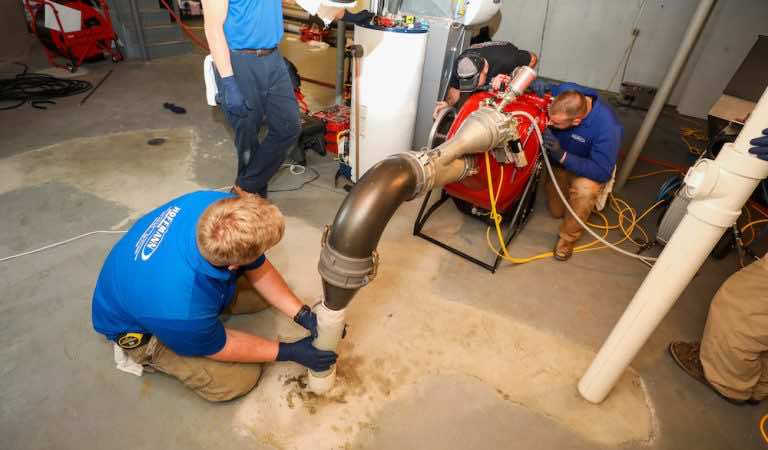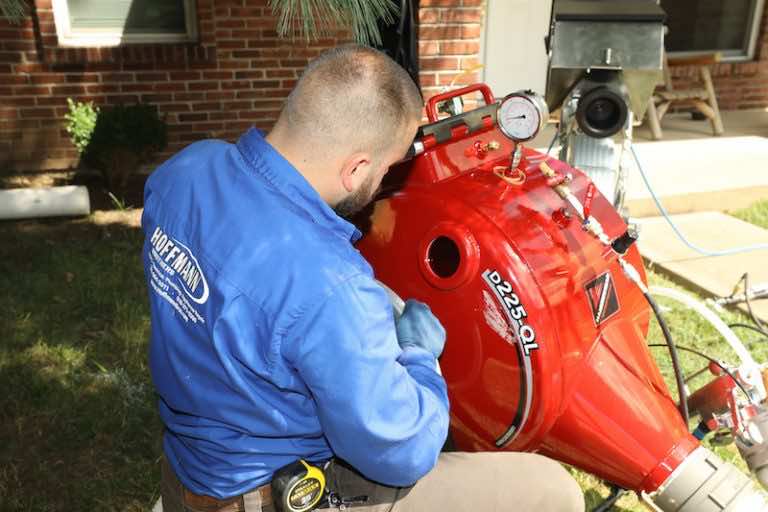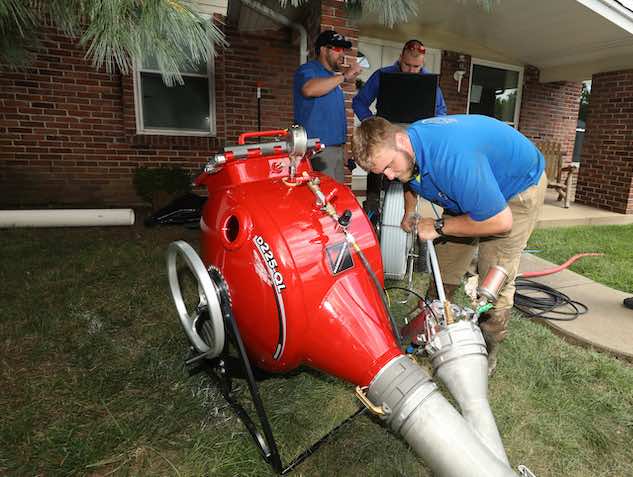Sewer pipe lining is a process used for repairing and replacing cracked, leaking, backed up and damaged sewer lines. Using a “no dig” trenchless process to avoid yard excavation, sidewalk destruction or digging up trees, sewer lining involves inserting new epoxy-saturated pipe tubing into existing pipes, inflating the tubing and curing it into place with hot air, steam or bluelight LED technology. This results in a new seal lining the walls of existing pipes, replacing broken piping with the potential to last for decades.

Pipe Lining Table of Contents
Click any below to jump to content
- Sewer Pipe Lining Process
- Origins of Trenchless Pipe Lining
- The Sliplining Process
- The Pipe Bursting Process
- Related Terms to Know
- Use “Sewer Pipe Lining” in a Sentence
- Benefits of Sewer Pipe Lining
- Popular Questions About Sewer Pipe Lining
- Other Helpful Resources
The Step By Step Process of Sewer Pipe Lining

How does sewer pipe lining work? Most often targeting the replacement of clay piping, cast iron, concrete, plastic and PVC pipes, the trenchless pipe lining process involves these steps:
- Sewer Camera Inspection – To confirm position of cracks and compromised pipes
- Cleaning Existing Pipes – Removing debris and other blockages
- Measurement of Existing Pipes
- Preparation of Tube Replacement – The replacement pipe tubing will typically be a felt tube made of fiberglass, polyester or similar materials.
- Epoxy Impregnation & Inversion of Tubing – The tube piping will be saturated or “impregnated” with an epoxy-resin and then flipped or “inverted” inside-out using an advanced inverter drum so that the epoxy-resin will be on the outside of the tubing, allowing it to be affixed to the walls of the existing pipes.
- Inserting Tubing Throughout the Compromised Pipes – The tubing will slide throughout the walls of the piping system until in place and ready for curing
- Curing of Tubing – This is what creates the new seal. Using popular technologies — traditional hot air or steam curing (4-12 hours drying time) or Bluelight LED curing (up to 5 times faster), all moisture is drawn out and the pipes can solidify in place
- Sewer Flow is Returned to New Pipes – Service to pipes can be restored once the curing process is complete.
Origins of Trenchless Pipe Lining
The first versions of replacing pipes involved thorough excavation of yards, tearing up driveways and sidewalks, downing trees and ripping up gardens. Trenchless sewer repair stepped in to offer a less invasive solution. Plumbing companies began their efforts with a process called sliplining, developed pipe bursting methods and have now incorporated pipe lining.
The Sliplining Process
Sliplining involves smaller carrier pipes that are inserted into the currently damaged piping system. These fully constructed pipes would be pulled through the cracked pipes and would rehabilitate the existing system. Water and sewer lines would be re-routed from the source to use these new carrier pipes and the cracked pipes would become obsolete.
The Pipe Bursting Process
Another method for trenchless pipe replacement that is still used in some scenarios is the pipe bursting process. This alternative to sewer pipe lining involves creating small entry and exit points above ground, pushing a new sewer pipe into an older damaged one and bursting the older pipe in the process.
Trenchless Pipe Lining – Related Terms

The most common words and phrases often used interchangeably with the sewer pipe lining process include:
- Epoxy Pipe Lining
- Sewer Pipe Relining
- Cured-In-Place-Pipe Lining – Typically abbreviated CIPP Lining
- UV Sewer Lining – known as Ultraviolet Cured-In-Place pipe lining
- Lateral Sewer Line
- Sewer Relining
- Internal Pipe Lining
- Drain Pipe Lining
- Internal Pipe Lining
- No Dig Sewer Relining
Sewer Pipe Lining Used in a Sentence
Instead of digging up our entire yard to repair the leaking pipe, let’s get the plumbing team to perform a trenchless sewer pipe lining with the new Bluelight LED technology.
The Benefits of Sewer Pipe Lining
Some of the most popular reasons homes and businesses turn to trenchless pipe lining include:
- No digging or excavation of property, saving trees and sidewalks
- Underground utilities can be spared the risk of damage
- Targets root intrusion and helps reduce erosion of pipes
- Avoids repaving after replacement is completed
- No need to stop traffic during work
- The flow of pipes can improve
- Money savings can be significant when avoiding excavation
FAQ’s About Sewer Pipe Lining
When you choose pipe lining for a repair or replacement, the pipes may typically reach a lifespan of about 50 years. Some severely damaged pipes may require replacement sooner.
Polyvinyl Chloride (PVC) pipes are generally preferred by plumbers and sewer line experts. They typically cost less and are easy to use.
The piping material generally determines the lifespan of sewer lines, pending any extensive unusual damage. Most sewer lines can last between 50-100 years, sometimes even longer.
We proudly offer pipe lining throughout the St Louis and Nashville areas. Click below to get started.
Other Helpful Pages:



